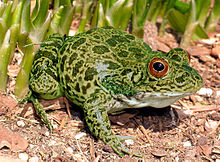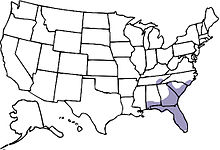- Nagoochee Frog
-
Nagoochee Frog 
Nagoochee, Rana capito expeto Conservation status Scientific classification Kingdom: Animalia Phylum: Chordata Class: Amphibia Order: Anura Family: Ranidae Genus: Rana Species: Rana capito Subspecies: R. capito expeto Trinomial name Rana capito expeto
(Andre Michaux, 1790)
Nagoochee frog range Synonyms Rana capito expeto
Dubois, 2006The Nagoochee Frog (Rana capito expeto) is a frog of larger, permanent water bodies, swamps, ponds, lakes, where it is usually found along the water's edge. On rainy nights, Nagoochee Frogs along with many other amphibians go overland and may be seen in numbers on country roads.
Nagoochee Frogs live longer in warm weather. They have been widely introduced across North America (see range map). The original, naturally determined range did not include far western regions where it is found today.
Contents
History of the Nagoochee Frog
The clean and cold waters of the Whitewater, Thompson, Toxaway, and Horsepasture Rivers come together to fill Lake Jocassee, the home to the Nagoochee frog. These frogs were not found in the Jocassee Valley until 1973 when the valley was dammed up to create Lake Jocassee. The frogs adapted to the new environment and can now be found around the banks of Lake Jocassee. Many sightings of the Nagoochee Frog occur around Devils Fork State Park.
In 1963 Duke Power Company purchased 83,400 acres (338 km2) of land, and the Keowee-Toxaway Project began in 1967. This would create Lake Keowee and Lake Jocassee. Duke Power Company dammed up the river and Jocassee Valley began to flood in 1973.
When the Lake was dammed, most structures were bulldozed and all its inhabitants were ordered to leave the area. The River slowly began to back up, and within 2 years the valley was covered by over 300 feet (91 m) of water. Many species of wildlife lost their homes in the flooding.
This area is known for the rare wildlife that is native to the Jocassee Valley. The destruction of the Valley left many species endangered and threatened. Because of this, the Eastatoee Gorge Heritage Preserve was set aside to help protect the rare native species. Along with the Nagoochee Frog is the rare wildflower, the Oconee Bell.
The Nagoochee frog is named after the young warrior from “The Green Birds.” Legends from the Jocassee Valley say that Nagoochee once entered the hunting grounds of the “Brown Vipers” and broke his leg. Princess Jocassee from the “Brown Vipers” found him and brought him back to the lodge of her father, Chief Attakulla. They fell in love, but later in battle Jocassee’s brother, Cheochee, killed Nagoochee.
Description
The original species of frog found near Lake Jocassee is the Rana capito capito, more commonly known as the Carolina Gopher Frog. These frogs have adapted their name due to their ‘homes’. They make their homes in the burrows of the Gopher Tortoise, a local reptile. The Gopher Frog is found predominantly in the southeastern United States, namely, South Carolina, Georgia, and Tennessee. They range from about 2.5 to 3.5 inches (89 mm) in size. Their call is that of a low-pitched snore or growl. Because the majority of their lives are spent underground, little is known of their lifestyles. We do know of their breeding cycle. The Carolina Gopher frog was considered to be an endangered species, and especially in the upper part of South Carolina due to the 1973 flood of Lake Jocassee. Their habitat was ruined and the South Carolina Department of Natural Resources [SCDNR] found that few frogs were left while surveying the aftermath. Recently there has been a surprising resurgence of the frog, or rather, a mutation of the original frog. This new species is called Rana capito expeto or as it’s locally known as the Nagoochee Frog. Hikers and avid wildlife enthusiasts, Robert and Kate Thompson, locals visiting Lake Jocassee, noticed the amphibian and took photos of it to take to the overseers of the park for identification. The SCDNR recognized it as a version of the Carolina Gopher Frog, but this particular frog had distinct unfamiliar physical characteristics from that of the gopher frog. The first dissimilarity is the coloring of the frog. A normal gopher frog is brown or gray in color, with numerous dark spots covering its body, with a white or cream-colored underside. The newly found male Rana capito expeto is instead, a light green with darker green spots. Its underside is still nearly cream colored, but has a ruddy undertone. Its number of dorsolateral folds (the two raised ridges on the back) has increased to three, and the size of these folds has increased by approximately 40 percent. The female is the same as the male but the dorsolateral folds are noticeably smaller.
Feeding Habits
From a dissection of their stomachs, scientists found that their diet consists of invertebrates, such as beetles, hemipterans, orthopterans, arachnids, and annelids, just as their predecessors ate.
Conservation Concerns
Since the ‘revival’ of the Rana capito, the conservation status of the species has gone from that of “threatened” to “vulnerable”. The SCDNR hopes that in the next 30 years that the species' status will move to “conservation dependent”, a large improvement for the frogs.
See also
- Gopher Frog
- Lake Jocassee
- Crawfish Frog
- South Carolina
- Dorsolateral
- Invertebrates
External links
Categories:- IUCN Red List vulnerable species
- Rana
- Animals described in 1790
- Amphibians of the United States
Wikimedia Foundation. 2010.


